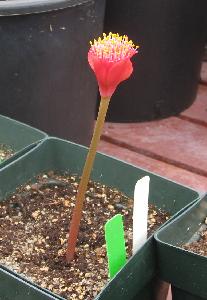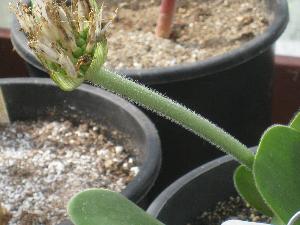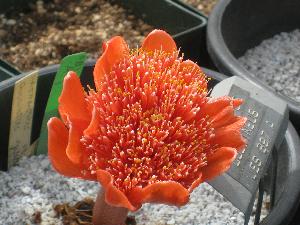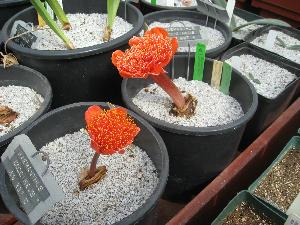Old Haemanthus Hybrids
Following tips from David Lehmiller of I.B.S., and the PDF file on-line of a paper on this subject, it appears that the various older names for Haemanthus sensu lato hybrids boil down to just two types of crosses: Scadoxus (katherinae X puniceus) and Haemanthus (albiflos X coccineus).
It seems that the plants from Scadoxus (katherinae X puniceus) are fertile, since I received seeds of the F2 of that cross from South Africa. None have grown large enough to bloom yet, but I am still hoping.
Plants from the old cross Haemanthus (albiflos X coccineus) have recently been re-created. Terry Hatch in New Zealand told me a year ago that he has bloomed numerous seedlings of this cross, and that the flowers come in a wide variety of different colors.
Also in fairly recent years, Aart van Voorst in the Netherlands has converted Haemanthus albiflos to the tetraploid form and has since crossed diploid H. coccineus on the tetraploid albiflos to produce hybrds with various colored flowers and with the additional property of being evergreen. These should have great potential as house plants in the future.
New Haemanthus Hybrids
Besides the Haemanthus 'Burgundy' strain that I have bloomed in the past three years, I have numerous seedlings starting to bloom from Haemanthus (barkerae X coccineus).
 This is the second of these hybrids to bloom. The size and shape of the umbel are roughly the same as for barkerae itself, but the color of the bracts is more intense and more orange than for barkerae. The peduncle height is distinctly shorter than for barkerae.
This is the second of these hybrids to bloom. The size and shape of the umbel are roughly the same as for barkerae itself, but the color of the bracts is more intense and more orange than for barkerae. The peduncle height is distinctly shorter than for barkerae.
Haemanthus (barkereae x coccineus)
No. 2069.C
I realized just the other day that a cross I though had failed, Haemanthus (albiflos x humilis hirsutus), actually succeeded. I have one surviving seedling from that cross, and it is very similar to albiflos except for one thing: the peduncle is covered with a dense coat of hair, while albiflos has a nude peduncle.
 Other than the hairy scape, the hybrid looks very similar to the seed parent, albiflos. When it bloomed for the first time this summer, I even pollinated it with albiflos pollen, thinking it was just another albiflos. I don't know yet whether there will be any seeds from that pollination.
Other than the hairy scape, the hybrid looks very similar to the seed parent, albiflos. When it bloomed for the first time this summer, I even pollinated it with albiflos pollen, thinking it was just another albiflos. I don't know yet whether there will be any seeds from that pollination.
Haemanthus (albiflos X humilis hirsutus)
No. 1539.B
Parent of Haemanthus 'Burgundy'
The pollen parent of Haemanthus 'Burgundy' is in bloom just now. It is Haemanthus coccineus No. 897.A, and its scape this time is fasciated. It has about 15 bracts, compared to 6 bracts on a normal scape. The peduncle is at least twice the width of the normal plant's.

|

|
|
Haemanthus coccineus No. 897.A
|
Fasciated (rear) vs. normal (front)
|
Good gardening,
Jim